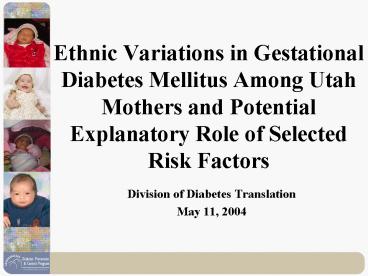Ethnic Variations in Gestational Diabetes Mellitus Among Utah Mothers and Potential Explanatory Role of Selected Risk Factors - PowerPoint PPT Presentation
1 / 32
Title:
Ethnic Variations in Gestational Diabetes Mellitus Among Utah Mothers and Potential Explanatory Role of Selected Risk Factors
Description:
Ensure language-appropriate information on gestational diabetes is available and distributed to mothers at risk Promote awareness of ways to prevent diabetes in the ... – PowerPoint PPT presentation
Number of Views:160
Avg rating:3.0/5.0
Title: Ethnic Variations in Gestational Diabetes Mellitus Among Utah Mothers and Potential Explanatory Role of Selected Risk Factors
1
Ethnic Variations in Gestational Diabetes
Mellitus Among Utah Mothers and Potential
Explanatory Role of Selected Risk Factors
- Division of Diabetes Translation
- May 11, 2004
2
- Gestational Diabetes Mellitus is . . . any
degree of glucose intolerance with onset or first
recognition during pregnancy.
ADA Position Statement, Diabetes Care, 2003
3
Consequences for the Mothers
- About 40 of mothers with gestational diabetes
will develop diabetes within 20 years of their
pregnancies - Some findings indicate rates as high as 70
within 28 years
Cousan, Diabetes in America,1995 Kim, et
al.Diabetes Care 25, 2002
4
Excess Risks of Pregnancy Complications for
Mothers with Gestational Diabetes
- Macrosomic baby
- Breech presentation
- Premature rupture of the membranes
- Pre-term birth
Yang, et al., Diabetes Care 25, 2002
5
Consequences for Offspring at Birth
- Neonatal hypoglycemia
- Jaundice
- Respiratory distress syndrome
Cousan, Diabetes in America, 1995
6
Long-term Consequencesfor the Offspring
- Increased risk of obesity
- Increased risk of diabetes
Dabelea, Hanson, Lindsay, Pettitt, Imperatore, et
al., Diabetes 49, 2000
7
Odds for Developing Diabetes Among Siblings by
Exposure to Diabetes in Utero Among Pima
Population
8
Diabetes Among the Pima Indians
- Both genetic and environmental risk factors
contribute to the high rate of diabetes in the
Pimas. In Pima Indian children aged 5-19 years,
the strongest single risk factor for type 2
diabetes was exposure to diabetes in utero.
Dabelea, Hanson, Lindsay, Pettitt, Imperatore, et
al., Diabetes 49, 20002208
9
Healthy People 2010 Objective 5-8
(Developmental)Decrease the proportion of
pregnant women with gestational diabetes
10
Prevalence of Gestational Diabetes Among Utah
Mothers
- Utah was one of the first states to differentiate
between pre-existing and gestational diabetes on
birth certificates - Hispanic/Latina mothers have a higher prevalence
of gestational diabetes than non-Hispanic/Latina
mothers - There appears to be a gradual but steady increase
in rates of gestational diabetes among Utah
mothers
11
Births to Mothers with Gestational Diabetes as a
Percentage of All Births
1.4
12
Risk Factors for Gestational Diabetes
- Risk factors are generally the same as for type 2
diabetes - Risk factors include age, body mass index
(pre-pregnancy), ethnicity, and socio-economic
status (education) - Parity
13
Contrasting Characteristics of Hispanic/Latina
and Non-Hispanic/Latina Mothers
Characteristic Hispanic/ Latina Mothers Non-Hispanic/Latina Mothers
Age 25.3 26.4 years
Pre-pregnancy BMI 24.7 24.1 kg/m2
Number of children 1.2 1.3 children
Education years 10.5 13.5 years
14
Methods
- We developed models to identify the factor or
factors that might explain the higher prevalence
of gestational diabetes in our Hispanic/Latina
mothers - We focused on singleton births
- We examined the effect of ethnicity, singly and
adjusting for the effects of known risk factors
15
Model 1 Likelihood of Obtaining Gestational
Diabetes
Gestational Diabetes
Ethnicity
plt.05 plt.01 plt.001
16
Model 1 ResultsHispanic/Latina mothers had a
70 percent higher risk of gestational diabetes
than non-Hispanic/Latina mothers
Utah Office of Vital Records and Statistics,
2000-2002
17
Model 2 Likelihood of Obtaining Gestational
Diabetes by Ethnicity with Controls
Gestational Diabetes
Ethnicity
BMI
Education
Parity
Age
plt.05 plt.01 plt.001
18
Model 2 Results
- Even after adjusting for known risk factors, we
still cannot explain the higher prevalence of
gestational diabetes among our Hispanic/Latina
mothers
19
Birth Place of Utah Hispanic/Latina Mothers
- One-third (33.1) were born in U.S.
- Over half (63.9) were born in Mexico
- Three percent were born elsewhere
20
Model 3 Likelihood of Obtaining Gestational
Diabetes by Birth Place with Controls
Gestational Diabetes
Mothers Birth place
BMI
Education
Parity
Age
plt.05 plt.01 plt.001
21
Model 3 Results
- Hispanic/Latina mothers born in U.S. had 50
higher prevalence of gestational diabetes than
non-Hispanic/Latina mothers - Hispanic/Latina mothers born in Mexico had 90
higher prevalence than non-Hispanic/Latina mothers
22
Model 3 Results
- Even after adjusting for known risk factors, we
still cannot explain the higher prevalence of
gestational diabetes among our Hispanic/Latina
mothers born in Mexico
23
What do we know about our Hispanic/Latina mothers
born in Mexico?
- They have relatively high rates of gestational
diabetes (4) - About one of 12 were age 35 or over
- Almost three-fourths dont have a high school
diploma
24
Percentage of Utah Hispanic/Latina Mothers Born
in Mexico 1989-2002
25
Conclusions
- Study of Utah birth records found a persistently
higher risk of gestational diabetes by ethnicity
even after adjusting for known risk factors - The risk appears to be particularly strong for
Hispanic/Latina mothers born in Mexico
26
Limitations
- Information is only as good as what is recorded
on the birth certificates - Information is not available on diet, exercise,
family history of diabetes - Data are cross-sectional i.e.,we have no way of
knowing if mother had gestational diabetes in any
prior pregnancy from birth records
27
What can we do?
- Ensure language-appropriate information on
gestational diabetes is available and distributed
to mothers at risk - Promote awareness of ways to prevent diabetes in
the future among diagnosed mothers - Work with Utah Medicaid and WIC programs to
promote awareness among our Hispanic/Latina
mothers about the importance of screening for
gestational diabetes
28
Promoting awareness among the public and among
providers
29
(No Transcript)
30
(No Transcript)
31
(No Transcript)
32
- Contact Information
- Brenda Ralls, Research Consultant
- Utah Diabetes Prevention and Control Program
- bralls_at_utah.gov
- http//health.utah.gov/diabetes































